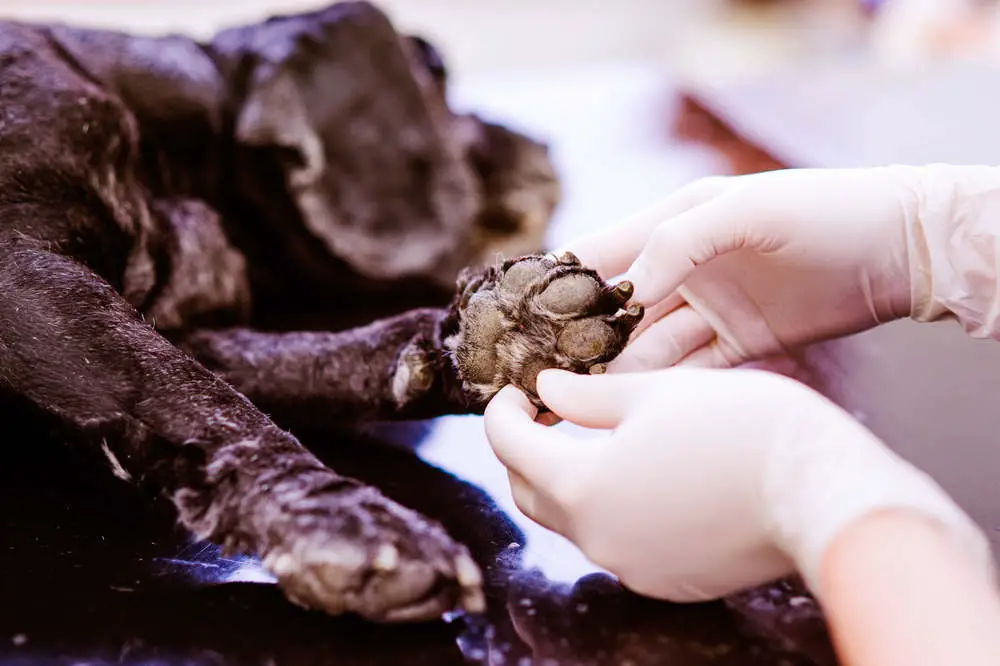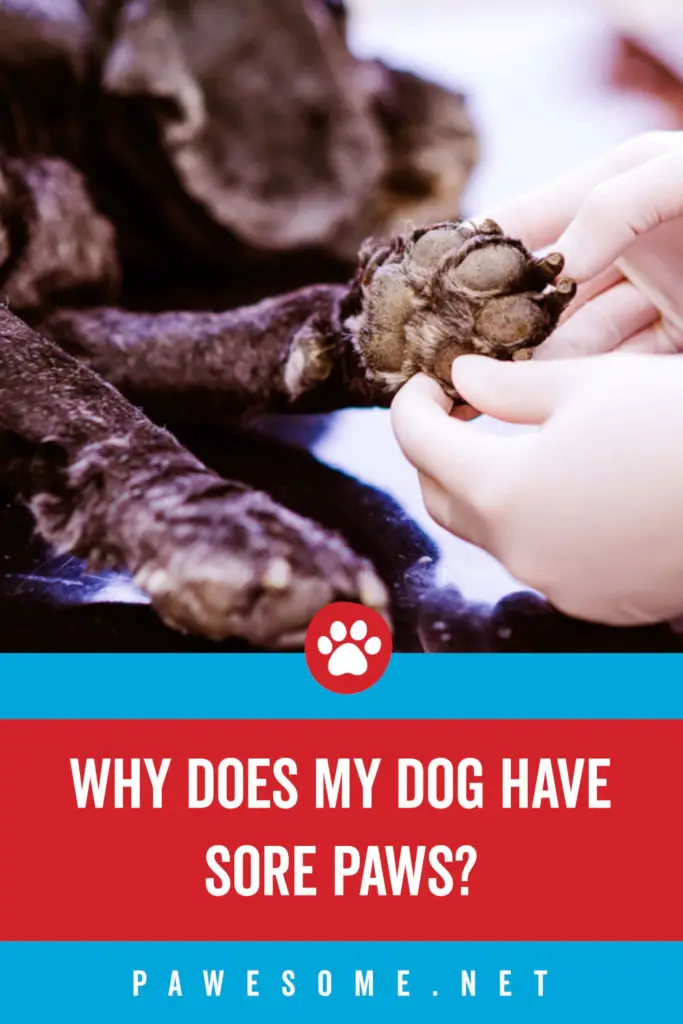
Dogs rely on their paws for almost everything, from walking and running to digging and playing. So when their paws are sore, it can be a real problem. Despite their tough exterior, a dog’s paws are susceptible to injury and irritation. There are many reasons why a dog might have sore paws, and it’s important to identify the cause in order to provide proper treatment.
Some common reasons for sore paws in dogs include cuts, infections, allergies, and burns. Dogs can also experience sore paws due to overuse, especially if they spend a lot of time walking or running on hard surfaces. It’s important to pay attention to your dog’s paws and look for signs of soreness, such as limping, licking or chewing on the paws, or reluctance to walk or play.
In this article, we’ll explore some of the most common reasons why dogs have sore paws and what you can do to help. We’ll also discuss preventive measures you can take to keep your dog’s paws healthy and happy. Whether you’re a seasoned dog owner or a new pet parent, understanding why your dog has sore paws is an important part of keeping them healthy and happy.
The Causes of Sore Paws
Dogs can experience sore paws for a variety of reasons. Understanding the underlying cause can help pet owners take appropriate measures to prevent and treat the issue. The following sub-sections outline some of the most common causes of sore paws in dogs.
Injuries
Dogs can get injured in a variety of ways, including cuts, scrapes, and burns. These types of injuries can cause pain and discomfort, and may lead to sore paws. Injuries can occur from walking or running on rough surfaces, such as pavement or gravel. Additionally, dogs can get injured from sharp objects, such as broken glass or thorns.
Broken nails are another common injury that can cause sore paws in dogs. When a nail breaks, it can expose the sensitive tissue underneath, causing pain and discomfort. Dogs may also experience hyperextension injuries, which occur when the paw is bent too far backward, causing strain on the ligaments and tendons in the paw.
Allergies
Just like humans, dogs can experience allergies that can cause sore paws. Allergies can be caused by a variety of factors, including food, pollen, and dust. When a dog is exposed to an allergen, their immune system may react, causing inflammation and irritation in the paws. This can lead to redness, swelling, and itchiness.
Some dogs may also experience allergies to certain materials, such as rubber or plastic. If a dog is exposed to these materials, it can cause an allergic reaction that can lead to sore paws.
Infections
Dogs can develop infections in their paws, which can cause soreness and discomfort. Yeast and bacterial infections are common causes of paw infections in dogs. These types of infections can occur when a dog’s paws are exposed to moisture, such as after walking in wet grass or mud.
Cysts and abscesses can also cause infections in a dog’s paws. These types of infections can be caused by foreign objects, such as splinters or thorns, or by injuries that break the skin.
Environmental Factors
The environment can also play a role in causing sore paws in dogs. Extreme temperatures, such as hot pavement or cold snow, can cause discomfort and pain in a dog’s paws. Additionally, exposure to chemicals, such as salt used to melt ice on sidewalks, can cause irritation and soreness.
Walking or running on rough or abrasive surfaces can also cause sore paws in dogs. Dogs that engage in a lot of physical activity may be more prone to developing sore paws due to the increased wear and tear on their paws.
Symptoms of Sore Paws
Dogs use their paws constantly, and it is not uncommon for them to experience soreness or discomfort in their paws. Some signs that your dog may be experiencing sore paws include:
Limping or Favoring a Paw
If your dog is limping or favoring a paw, it may be a sign of soreness or pain in their paw. They may be hesitant to put weight on the affected paw or may be walking with a limp.
Chewing or Licking Paws
Dogs may also try to alleviate the discomfort in their paws by chewing or licking them excessively. This can lead to further irritation and even cause open sores or infections.
Redness or Swelling
Redness or swelling in the paw area is another sign of soreness. The paw may appear inflamed, and there may be visible swelling or heat.
Discharge or Bleeding
If your dog’s paws are sore, there may be discharge or bleeding present. This can be a sign of an infection or injury and should be addressed by a veterinarian.
If you notice any of these symptoms, it is important to address the issue promptly to prevent further discomfort or complications.
Also Read: Why Are My Dog’s Paws Pink and Black?
Diagnosis and Treatment
Veterinary Examination
If your dog has sore paws, it is important to take them to a veterinarian for a thorough examination. The vet will examine the paws and may recommend further tests to determine the underlying cause of the soreness. This may include skin scrapings, blood tests, or X-rays.
Topical Treatments
Depending on the diagnosis, the vet may recommend various topical treatments to help soothe and heal your dog’s sore paws. This may include medicated foot soaks, ointments, or creams. It is important to follow the vet’s instructions carefully and apply the treatments as directed.
Oral Medications
In some cases, the vet may prescribe oral medications to help treat the underlying cause of the sore paws. This may include antibiotics, antifungal medications, or pain relievers. It is important to follow the vet’s instructions carefully and give the medications as directed.
Surgical Procedures
In severe cases, surgery may be necessary to treat the underlying cause of the sore paws. This may include removing a foreign object, repairing a broken bone, or removing a tumor. Your vet will discuss the options with you and recommend the best course of action. Overall, the key to treating sore paws is to identify the underlying cause and follow your vet’s instructions carefully. With proper treatment and care, your dog’s paws can heal and they can return to their happy and active selves.
Preventing Sore Paws
Regular Paw Inspections
One of the best ways to prevent sore paws in dogs is to regularly inspect their paws. This can help identify any cuts, blisters, or foreign objects that may be causing discomfort or pain. Pet owners should examine their dog’s paws after each walk or outdoor activity. They should also be on the lookout for any changes in their dog’s gait or behavior that may indicate pain or discomfort.
Proper Grooming
Regular grooming is also important for preventing sore paws in dogs. This includes trimming their nails, keeping the fur between their paw pads trimmed, and cleaning their paws after walks or outdoor activities. Long nails can cause discomfort and make it difficult for dogs to walk properly, while excessive fur can trap dirt and debris that can irritate their skin.
Protective Footwear
Protective footwear can also help prevent sore paws in dogs. This is especially important for dogs that spend a lot of time outdoors or on rough surfaces. There are many different types of dog boots and shoes available that can provide protection and support for their paws. Pet owners should choose footwear that fits properly and is made from durable materials.
Avoiding Irritants
Finally, pet owners should be aware of any irritants that may be causing sore paws in their dogs. This can include hot pavement, salt or chemicals used to de-ice sidewalks, and certain types of grass or plants. Pet owners should try to avoid these irritants whenever possible or take steps to protect their dog’s paws, such as using protective footwear or washing their paws after walks.
Paw Balm and Wax
Paw balms and waxes are essential products that can help maintain the health of your dog’s paws and prevent soreness. These products are designed to moisturize and protect the paw pads, keeping them supple and resistant to cracking, drying, and injuries caused by rough surfaces or harsh weather conditions.
When selecting a paw balm or wax, it’s important to choose a product made with natural ingredients that are safe for your dog. Look for products containing ingredients like shea butter, beeswax, and coconut oil, which provide hydration and protection without causing irritation or harm if ingested.
Also Read: How To Use Dog Nail Clippers
Final Thoughts
In the end, our furry friends depend on their paws for just about everything, so it’s essential for us, as pet parents, to be proactive in taking care of them. By understanding the common causes of sore paws and following the simple solutions provided in this article, you can help ensure your dog’s paws remain in tip-top shape.
Remember, prevention is always better than cure! Keep an eye out for any changes in your dog’s behavior or the appearance of their paws, and don’t hesitate to seek professional help if you’re concerned. With regular paw inspections, proper grooming, protective footwear, and the use of paw balms or waxes, your dog’s paws will stay healthy and pain-free.
So, let’s keep those paws in the best condition possible and let our beloved canine companions continue to explore the world around them, play, and bring joy to our lives. After all, their happiness and well-being are truly worth every bit of effort we put in to keep their paws healthy and comfortable. Happy trails!

